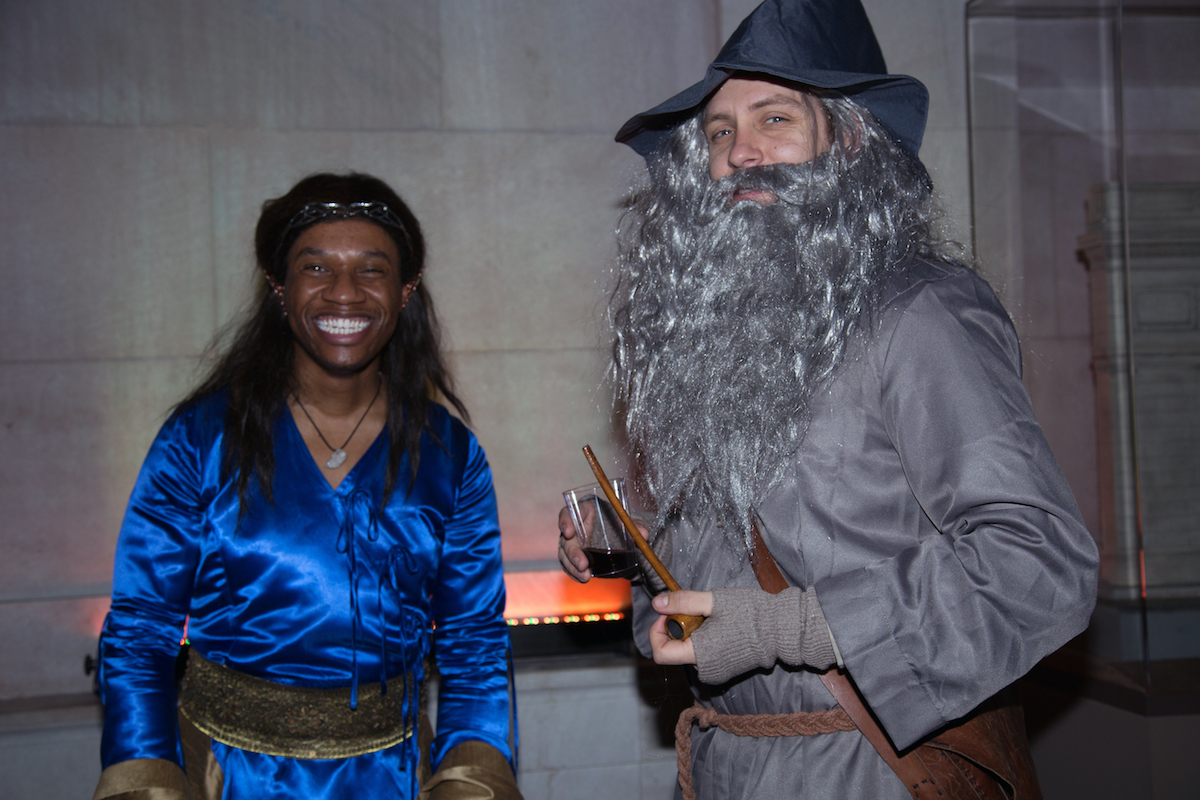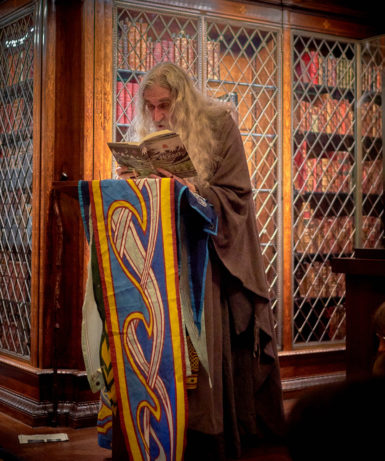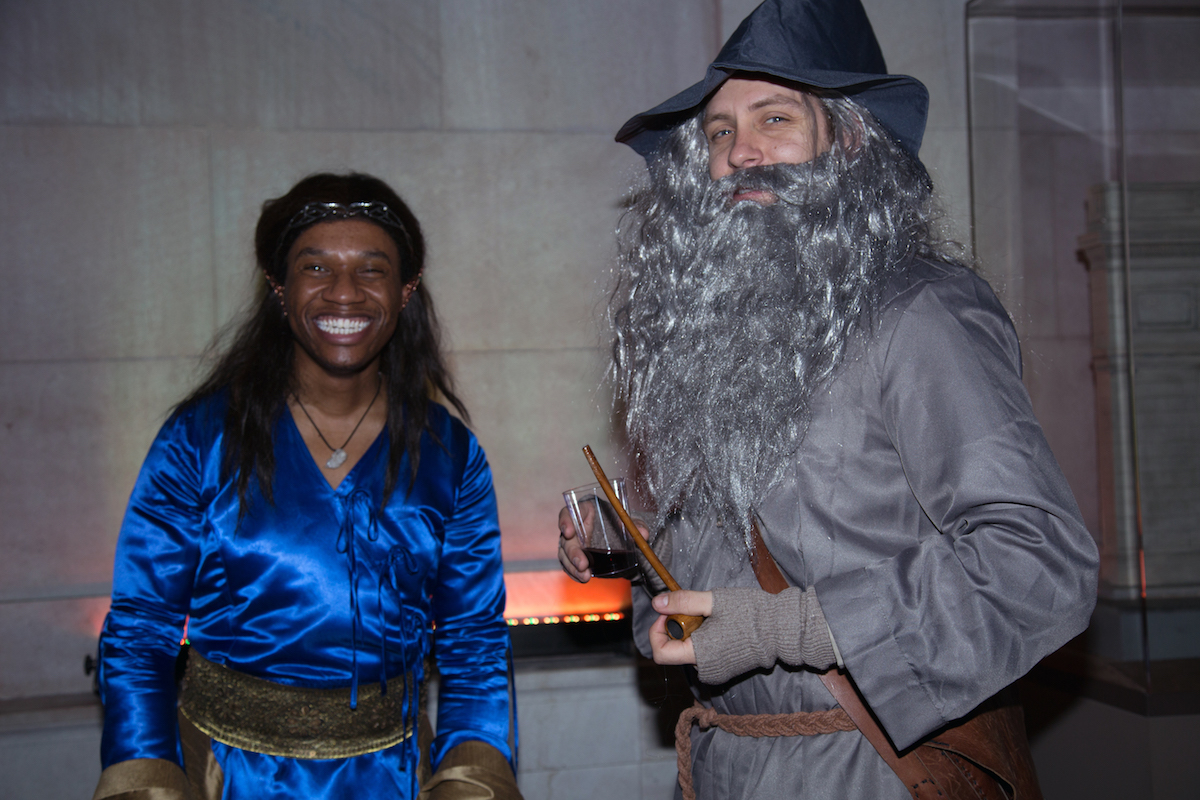[ad_1]

LIZ ZITO/COURTESY MORGAN LIBRARY & MUSEUM
I know nothing about J. R. R. Tolkien. I’ve never read a page of his many books, which include Lord of the Rings and The Hobbit, or seen any of the famous film adaptations of his work. I could barely pick Gollum out of a police lineup. I am in no way admitting this as a point of pride, but simply stating a matter of fact. In any case, when my editors asked if I would cover a Tolkien-themed event at New York’s Morgan Library & Museum—home for one more month to the exhibition “Tolkien: Maker of Middle-earth”—I was more than happy to dive into a universe for which I had very little reference.
Waiting in line for the “Very Important Hobbit” preview hour, before the museum opened its doors to 600 more costumed revelers later in the evening, the first thing I witnessed was a Tolkien fan changing out of a pair of Saucony sneakers into Ugg boots modified to look like hobbit feet. “We’ll see how they hold up,” he said, before commenting that he thought the current iteration of his home-brewed shoes were “much improved” from a pair he had sported at a recent Renaissance faire.

AJ STETSON/COURTESY MORGAN LIBRARY & MUSEUM
Once inside, Michael Reid, the Morgan Library’s manager of marketing, told me a bit about the exhibition itself, which debuted at the Bodleian Libraries at the University of Oxford in England. It featured all sorts of material culled from the author’s vast archives, including manuscripts, letters to his children, and detailed watercolors—all part of the bedrock of Tolkien’s sprawling universe.
“We like to show the creative genesis of great works of art, so to be able to show Tolkien’s manuscripts—the way he wrote Elvish back in the day—along with his watercolors for his book jackets [is] a perfect Morgan exhibition,” Reid explained. As for his own personal fandom, Reid said he fell in love through Peter Jackson’s movies. “A lot of millennials are in the same boat—that’s our exposure,” he said. “To go back and see the origins of that franchise is so fascinating.”
The night featured a “peasant feast,” based on a party in Lord of the Rings: The Fellowship of the Ring to celebrate the birthday of Bilbo Bagans, that involved almonds and addictive bread-cracker twists. I was pretty hungry and hoping for a turkey leg similar to what I recall my father eating during my one and only experience at a Renaissance faire, but it was not to be.
Live entertainment for the night was provided by a self-described “folk fantasy” act called the Lonely Mountain Band. Speaking to the group’s founder, John Di Bartolo, I learned that the band has its roots in the Celtic rock group King Celtic—but, he explained, “I’ve always written Tolkien-inspired songs.” At the Morgan, they played as a trio—usually they have a piper in the mix, but he had a funeral in Ireland to attend—and they whipped the crowd into a semi-fury. Many a jig was danced. “We’re the only band that does stuff like this, as far as I know, in the tri-state area,” Di Bartolo said.
Close to the Lonely Mountain Band was a merchandise table tended by the husband-and-wife duo Anthony Burdge and Jessica Burke. In addition to CDs, they were selling their own novels. Burdge is an independent Tolkien scholar who founded the New York Tolkien Society, and he trained tour guides at the Morgan on the finer points of the current exhibition. “My parents have told me they read the Hobbit and Lord of the Rings to me in utero,” he said. “And here I am, 47 years later. Tolkien has been embedded in my DNA since birth.”

AJ STETSON/COURTESY MORGAN LIBRARY & MUSEUM
Burdge, who would later assist in a marathon reading of The Hobbit inside J. Pierpont Morgan’s brooding library, said he has been involved in “Tolkien academia” for 17 years, and he even met his wife in the Tolkien section of a bookstore. Burke, for her part, is an adjunct professor at the City University of New York whose interest in Tolkien similarly started early. “When I was younger, I had trouble reading—I’m dyslexic,” she said. “My mom was trying to find other ways of helping me learn how to read, so we would get records out of the library of stories.” One record she loved but did not know by name was stolen from the library, but years later, Burke was reacquainted when she delved into Tolkien books whose covers she had deemed too scary to crack. “I finally got up the courage to pick up the books,” she said—and it was then that she realized what she had listened to years before, as she recalled certain chapters by heart.
When I asked assembled Tolkien fans how I, as an adult, could get into the material, most suggested starting with The Hobbit. I was told to stay away at the start from The Silmarillion, the posthumously published volume that Burdge said “reads like the Bible.” Talking to Brenton and Kaile Bennett, who travelled from Connecticut and were dressed up as Gollum and Galadriel, respectively, confirmed that The Silmarillion was best reserved for aficionados. “If you really want to start getting into the nuances and the history, The Silmarillion is kind of where to go,” Kaile Bennett said. “That one reads more like a history book than an enjoyable story,” added Brenton, whose Gollum costume was accessorized with a gold dinner jacket.
Employees of the Morgan seemed to be happy about the energy in the building. “It’s brought a very different demographic, and I think a much more animated group of people then we’re used to seeing here,” a Morgan employee told me. “If one in 20 of the people that have come for this exhibit come back again, we’ll all be happy.”
[ad_2]
Source link

